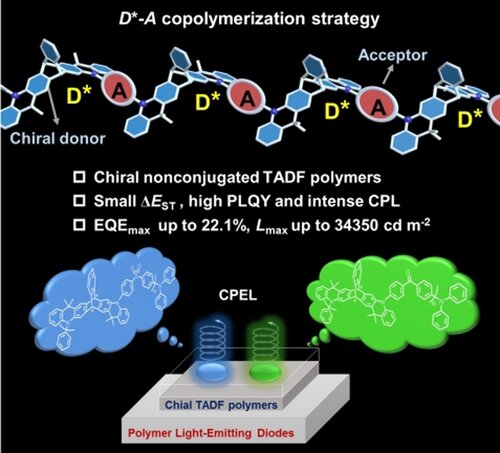Click here to sign in with or
Forget Password?
Learn more
share this!
2
7
Share
Email
December 6, 2021
by Liu Jia, Chinese Academy of Sciences
A beam of light can be divided into left-handed and right-handed polarized light by physical methods. Chiral fluorescent materials can emit different left-handed and right-handed polarized light when they are excited, which is called circularly polarized luminescence (CPL). To take full advantage of this property, circularly polarized organic light-emitting diodes (CP-OLEDs) can be fabricated with chiral fluorescent emitters to obtain circularly polarized electroluminescence (CPEL). CPEL has attracted extensive attention.
In order to achieve highly efficient CPEL, thermally activated delayed fluorescent (TADF) materials have been widely used in CP-OLEDs since Prof. Chen Chuanfeng’s group from the Institute of Chemistry of the Chinese Academy of Sciences (ICCAS) firstly reported TADF-based CP-OLEDs in 2018. TADF emitters have been regarded as third-generation luminescent materials since they can utilize both singlet and triplet excitons via reverse intersystem crossing (RISC) process. Therefore, TADF-based OLEDs can achieve theoretically 100 percent internal quantum efficiency (IQE).
In a new study published in Angewandte Chemie, Prof. Chen’s group reported new progress on chiral-polymers-based CP-OLEDs which achieved intense CPEL properties. This is the first report of CPEL detected from CP-OLEDs fabricated with chiral TADF-active polymers.
The researchers designed and synthesized two pairs of chiral TADF polymers with a strategy of chiral donor-acceptor (D*-A) copolymerization, which was first proposed by the group. The chiral donor moiety has a rigid triptycene scaffold which can provide chirality as well as break the conjugation of the polymer backbone. The benzophenone diphenyl sulfone unit and benzophenone unit were used as the acceptor moieties to prepare the two pairs of polymers.
The researchers then fabricated solution-processed CP-OLEDs using the two pairs of polymers as the emitting materials. The corresponding devices achieved outstanding performances with high maximum external quantum efficiency (EQEmax) of up to 22.1 percent, high maximum brightness (Lmax) of up to 34,350 cd/m2. Intense mirror-image CPEL signal was detected in such highly-efficient CP-OLED devices.
It is believed that the experimental results proved the effectiveness of the new strategy of D*-A copolymerization for realizing CPEL. The study provides a new perspective for the research field of CPEL.
Explore further
How copper makes organic light-emitting diodes more efficient
Explore further
Facebook
Twitter
Email
Feedback to editors
8 hours ago
0
8 hours ago
0
10 hours ago
0
Dec 03, 2021
0
Dec 03, 2021
0
2 hours ago
2 hours ago
3 hours ago
3 hours ago
3 hours ago
3 hours ago
4 hours ago
10 hours ago
Dec 05, 2021
Dec 04, 2021
Dec 03, 2021
Dec 02, 2021
Dec 02, 2021
More from Other Physics Topics
Jan 08, 2016
Oct 21, 2021
Jan 12, 2021
Jun 30, 2016
Sep 08, 2020
Jun 25, 2021
Nov 30, 2021
Nov 24, 2021
Nov 17, 2021
Nov 15, 2021
Nov 12, 2021
Nov 05, 2021
Use this form if you have come across a typo, inaccuracy or would like to send an edit request for the content on this page. For general inquiries, please use our contact form. For general feedback, use the public comments section below (please adhere to guidelines).
Please select the most appropriate category to facilitate processing of your request
Thank you for taking time to provide your feedback to the editors.
Your feedback is important to us. However, we do not guarantee individual replies due to the high volume of messages.
Your email address is used only to let the recipient know who sent the email. Neither your address nor the recipient’s address will be used for any other purpose. The information you enter will appear in your e-mail message and is not retained by Phys.org in any form.
Get weekly and/or daily updates delivered to your inbox. You can unsubscribe at any time and we’ll never share your details to third parties.
More information Privacy policy
Medical research advances and health news
The latest engineering, electronics and technology advances
The most comprehensive sci-tech news coverage on the web
This site uses cookies to assist with navigation, analyse your use of our services, collect data for ads personalisation and provide content from third parties. By using our site, you acknowledge that you have read and understand our Privacy Policy and Terms of Use.





